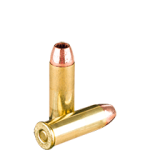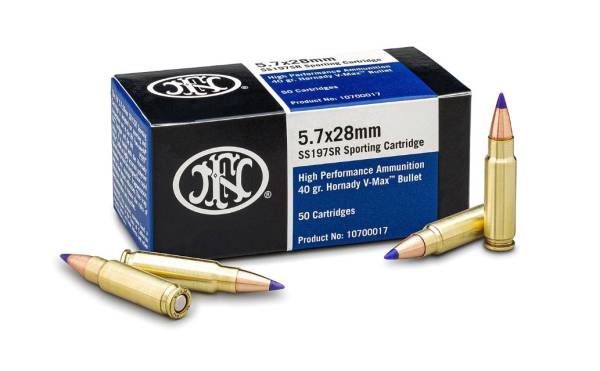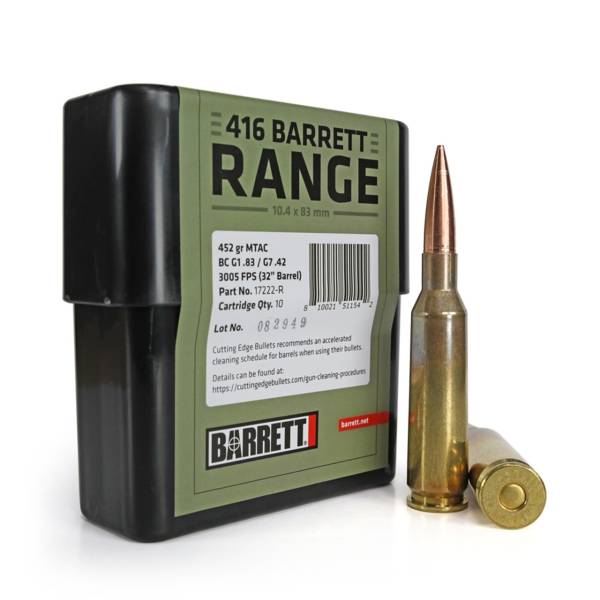Description
Made popular in the 1950s by writer Elmer Keith, the .44 Magnum is a great choice for handgun hunting. It will easily take game such as deer and hogs and has a wide variety of ammunition choices – making the .44 Mag an excellent cartridge for almost any hunt.
Released to the American public in 1956, the .44 Remington Magnum, most commonly known as the .44 Magnum, is both an iconic and an efficient round. The result of a combined effort from gun writer and enthusiast Elmer Keith, firearms manufacturer Smith & Wesson, and Remington Arms Company, this large-bore round spent many years as the world’s strongest handgun cartridge. While it’s no longer the strongest or the biggest with today’s modern ammunition, the .44 Mag is still a tried-and-true favorite from coast to coast.
The standard .44 Magnum bullet weights 240 grain (gr), travels at a velocity of 1,350 feet per second (fps) and generates muzzle energy of 971 foot-pound energy (ft·lbs). It features a .429-inch lead bullet that sits in a straight-walled case that is 1.285 inches long. Together, the ammunition reaches a total length of 1.61 inches, uses a large pistol primer, and can be loaded to a maximum pressure of 36,000 pounds per square inch (psi).
Although the .44 Mag’s case is slightly longer than its parent case, the .44 S&W Special, it’s not because it holds more powder. Instead, the stronger ammunition was designed that way to stop accidental loading into older revolvers chambered for the .44 Special that couldn’t withstand the Magnum’s force. Because of this, .44 Special rounds can be fired from revolvers chambered for .44 Magnum, but it’s not possible to shoot .44 Mags from those chambered for the .44 Special.
Originally designed for revolvers, there are now firearms chambered for the .44 Magnum in many styles, including semi-automatic pistols, carbines, and lever-action rifles.
Development of the .44 Magnum Ammunition
Elmer Keith developed the .44 Magnum cartridge after spending years custom loading the .44 Special. Wanting to develop a cartridge based on a .44 caliber bullet that would be suitable for handgun hunting, he created high-pressure loads that pushed a heavy bullet faster and stronger than what was currently available in ammunition with such a large bullet.
Keith approached Smith & Wesson, and the .44 Magnum was born through a collaboration between Remington, which made the ammunition, and the firearms company, which created the Model 29 for the cartridge. Smith & Wesson gave Keith the prototype in December of 1955 before releasing the new revolver to the American public in 1956.
Although the ammunition had its start with Smith & Wesson, it wasn’t actually Smith & Wesson that released the first .44 Mag handgun. Before the public introduction of the Model 29, an employee at Sturm, Ruger & Company found long .44 Magnum shells at a scrapyard and deduced that the company was going to release a new cartridge.
Ruger quickly designed and produced the iconic single action .44 Magnum Blackhawk revolver in 1956, right before the public debut of the Smith & Wesson Model 29. Because this Blackhawk was more affordable and readily available, it quickly rose in popularity.
Shooting the .44 Mag
There’s a reason the .44 Magnum remains one of the most popular commercial, large-bore cartridges today. Since the Magnum round is loaded to high pressure, it has a greater velocity and more energy than similar-sized projectiles and, therefore, greater performance. It travels fast and hits hard.
The .44 Mag is also an extremely accurate round. It gives precise shot placement and has a deeply penetrating bullet. In its standard form, the .44 Mag bullet can easily penetrate an automobile and can shoot through ballistics gel without issue. It should be noted that because of the combination of the bullet’s heavyweight, high velocity, and strong muzzle energy, the projectile’s trajectory begins to significantly drop after about 100 yards.
In most handguns chambered for .44 Magnum revolver ammo, single-action tends to be easier to shoot than double action. These wheel guns offer a more comfortable grip to help the shooter handle the guns’ weight and the ammunition’s force.
While the .44 Mag is strong and efficient, it comes at a price. The high-pressure cartridge has heavy recoil and muzzle flash and produces a rather large bang. Even experienced shooters need some practice with .44 Mag ammo to become comfortable, and it’s not recommended for novice shooters or those with small hands.
For those who aren’t seasoned shooters (or those with small frames), opt for .44 Special cartridges instead of .44 Magnum. These rounds can be shot from .44 Mag revolvers and have less power and recoil, making them easier to handle with less stress on the shooter.
Finding a handloader is another solution. The .44 Magnum rounds offer a lot of flexibility in how they’re hand-loaded, and many of those who reload ammunition can tweak the cartridge to their own liking.
Wearing a shooting glove, which provides extra cushion to the shooter’s palm and hand, can also make shooting this heavy-hitting ammunition easier.
Uses for .44 Magnum Ammo
Originally, the .44 Magnum was introduced as a hunting cartridge for revolvers. Keith, the man who developed the high-pressure round, had been hot-loading the .44 S&W Special case for years, trying to create ammunition that used a large-caliber bullet that could meet the performance standards set by the .357 Magnum. Although the .357 Mag had a smaller bullet than the large calibers of the time (which included the .44 Special and the .45 ACP), it was faster and hit harder than either of these bullets could manage.
Yet with the .44 Mag, Keith succeeded. He created large-caliber ammunition that was finally able to reach supersonic speeds and create massive amounts of stopping power. As a hunting cartridge, .44 Mag bullets can take out any of North America’s large game within close quarters.
Firearm manufacturers have made many types of firearms to accommodate the .44 Magnum, including rifles with bolt action, lever action, and semi-automatics. These rifles, when paired with .44 Magnum rifle ammo, have been used for medium-sized game, such as whitetail deer and feral hogs, with great success. They’re often compared to shooting a .30-30 lever-action rifle.
The .44 Mag has also proven itself capable of effectively harvesting black bear, Cape buffalo, and elk, and many big game hunters have even protected themselves against polar bears and elephants with the ammunition. It’s the sidearm that many hunters carry even when rifle hunting, especially when they’re in the dangerous game territory. It’s the go-to for both those who hunt in Alaska and those who live in its wilderness.
Beyond hunting, the .44 Mag can be used for self-defense and military purposes. Although some law enforcement officers may carry a firearm chambered for .44 Magnum, police departments don’t issue it as the standard sidearm due to its heavy recoil and high muzzle energy. This combination makes rapid-fire difficult, and with the risk of over-penetration, it’s not the right choice for all law enforcement officers.
The Most Powerful Handgun in the World: S&W Model 29
While the .44 Magnum is a fine round that saw immediate success on its own, it reached new heights of popularity in 1971, with the release of Dirty Harry. In this classic Western, San Francisco police inspector, “Dirty Harry” Callahan, who was played by Clint Eastwood, carries the Smith & Wesson Model 29 revolver in a shoulder holster.
The gun serves Harry well throughout the film, and in one famous scene, he has his wheel gun pointed at the villain and says:
“Uh uh. I know what you’re thinking. ‘Did he fire six shots or only five?’ Well, to tell you the truth, in all this excitement, I kinda lost track myself. But being this is a .44 Magnum, the most powerful handgun in the world and would blow your head clean off, you’ve gotta ask yourself one question: ‘Do I feel lucky?’ Well, do ya, punk?”
After the release of Dirty Harry, the American public went crazy for the Model 29, and every gun enthusiast (and movie fan) wanted one. Within a short period of time, the demand for the Model 29 far outreached the supply, and people were paying three times the suggested retail price for the revolver.
While it’s safe to say that the .44 Mag was one of the most powerful handgun cartridges of the time (and Model 29 is a very powerful gun), with modern ammunition, it’s no longer the case. But that doesn’t stop the ammo or the firearm from remaining a highly sought-after, iconic classic.
When Smith & Wesson originally released the Model 29, it was in blued steel, with a six-shot cylinder. It had barrel length options ranging from four to 10 inches, and when fully loaded, weighed nearly three pounds. In the year it was released, Smith & Wesson produced 3,100 of the six-shooters, each with the suggested retail price of $140.
Other Popular Firearms Chambered for the .44 Magnum
Although the .44 Magnum was originally created for revolvers, it didn’t take long for manufacturers to start creating other types of firearms for the powerful cartridge. By the 1960s, semi-automatic carbines had hit the market. In 1961, Ruger released the company’s first long gun, a semi-automatic carbine chambered for the .44 Mag called the Ruger Model 44 carbine. Just a few years later, Marlin released a lever-action .44 Mag rifle in its Model 1894.
During the Vietnam War, the U.S. Army commissioned the manufacturing of the Quiet Special Purpose Revolver, which became known as the QSPR. Chambered to .44 Magnum, this revolver was used by “tunnel rat” soldiers who carried the handgun while exploring the Viet Cong tunnels.
The revolver was a converted Model 29 with a short, 1.3-inch barrel and featured internal suppression, reducing the firing noise to 110 decibels. While still extremely loud, this lower volume allowed the revolver to be used in tunnels without causing excruciating pain to the shooter.
The QSPR was compact and lethal, especially at the point-blank range, it was used for. The Army issued shotshell cartridges, which each contained 15 tungsten balls that sprayed across its target on impact.
Today, perhaps the most well-known semi-automatic .44 Magnum pistol is the Desert Eagle, which became a pop icon when it graced the cover of Playboy magazine with Pamela Anderson. While many think of .50 AE ammo when they think of the Desert Eagle, it’s available in other calibers, including the .44 Magnum.
.44 Magnum Ammo
For the last 50 years, ammunition manufacturers have continued to produce enough innovative cartridges for the .44 Mag caliber to keep up with the steady demand. Federal Premium offers .44 Mag in their Hydra-Shok line, as well as Vital-Shok and Power-Shok, and traditional hollow point and soft point bullets. Hornady produces their Critical Defense line in .44 Mag as well.
These are only a few examples of the many choices buyers have in .44 Magnum cartridges that are made by nearly all major ammunition producers. The .44 Mag remains a powerful and versatile cartridge, useful for hunting and self-protection, not to mention just plinking with friends.
Why is the .44 Mag Not .44 caliber?
Unlike most American ammunitions, the .44 Remington Magnum bullet (and its parent, the .44 S&W Special) isn’t .44 caliber ammo. Instead, the actual flat-tipped bullet measures between .429 to .430 inches. When the precursors to the modern .44 ammunition (the .44 Russian and the .44 American) were created, caliber sizes were measured differently than they are today, from the outside of the ammo’s casing.
When S&W created the .44 Special and the .44 Magnum, they decided to continue with the same caliber name for marketing purposes, even though modern ammunition measures the actual projectile’s diameter instead of the casing’s. Instead of trying to market a whole new ammunition size, they went with the old measurement system and kept the caliber size that originated in the mid-1800s.
Common Names for the .44 Mag
Like other ammunition rounds, the .44 Magnum is a cartridge known by many names. Some of these names are correct, and some are not. Common names include:
.44 Remington Magnum
.44 Magnum
.44 Mag
10.9x33mmR
.44 Caliber
.44 Ammo
All of these options are correct, except for the last two. Both of these terms could reference either the .44 Magnum or the .44 Special.
Sometimes, the cartridge is referenced without the decimal point, such as 44 Magnum or 44 Mag. While the true meaning of these terms remains, they’re not grammatically correct. Since it’s a decimal point referencing a specific caliber or measurement, in this case, .44 inch, it’s necessary to include it when writing the ammunition name.
Whether the .44 Remington Magnum is loved because of its accuracy and power or because of its pop icon status, the fact remains that this high-power, large-bore ammunition is an American favorite. From Dirty Harry’s Model 29 to the famous Desert Eagle, the .44 Mag has grown from its humble beginnings as a reload to one of the country’s top calibers.
.44 Mag vs. .45 ACP
While some people may say comparing the .44 Magnum to the .45 Automatic Colt Pistol (ACP) is like comparing apples to oranges, the ammunition actually has some similar characteristics. When it comes to size, the .45 ACP bullet measures just slightly bigger than the .44 Mag (.451 inch compared to .429 inch) but sits in a shorter casing, with the total cartridge length .335 inch shorter than the Magnum.
Things begin to change more significantly when we look at performance. Designed in the 1950s as a high-pressure revolver round, SAAMI states the maximum pressure of the .44 Mag is 36,000 psi, while the 100-plus-year-old semi-automatic .45 ACP is rated to only 21,000 psi. This pressure plays a significantly on the cartridge’s performance. With a 240 gr bullet, the .44 Mag can reach an average velocity of 1,180 fps with 741 ft·lb muzzle energy. On the other hand, a 230 gr .45 ACP bullet reaches 835 fps with 356 ft·lb muzzle energy.
For shooting purposes, these ballistics give the .44 Mag more recoil and muzzle blast, making it more difficult to control than the .45 ACP. That’s why the ACP can still be found in the holsters of some law enforcement officers, while the .44 Mag has often been deemed too big for an effective duty piece. This makes sense, considering the ACP was designed for duty and self-defense, while the initial purpose of the .44 Mag was created for hunting America’s large game.
Where the .45 ACP does trump the .44 Mag is carrying capacity. Semi-automatic firearms chambered for the ACP are easier to carry concealed and often have a round capacity between eight and 15. Revolvers for the .44 Mag hold no more than six rounds and are typically large, heavy weapons, making them difficult to conceal. They also take longer to reload, which is a self-defense situation, can be a deciding factor.
FAQ
Can you reload .44 Magnum ammo?
The .44 Magnum, which itself was spawned as a wildcat of the .44 S&W Special, is ideal ammo to reload. The cartridge has a wide range of flexibility for handloaders, who can make the round more or less powerful with a slight bit of adjustment.
What is the most powerful .44 Mag ammo?
All .44 Magnum ammo is powerful, as the round was created as a revolver hunting cartridge and can harvest any of North America’s large game, including black bear, cape buffalo, and elk. The large bore ammo reaches supersonic speed and has massive amounts of stopping power. If you want the most power possible, consider hollow point options or specialty rounds from Federal or Hornady.
What is the best 44 Magnum ammo for hunting?
As the .44 Magnum was built for hunting, many of the available ammunitions are appropriate for harvesting game. If hunting large game, consider a bullet weight of at least 240 grain and opt for a jacketed hollow point or XTP round. If using a lever-action long gun in .44 Mag, consider Hornady’s LEVERevolution.
How much does 44 Mag ammo cost?
The price of .44 Mag ammo depends on the type of ammo purchased and the quantity. Soft point ammo is cheaper than specialty rounds, like Barnes Vortex, and bulk ammo tends to be cheaper than purchasing single boxes at a time. The average prices of .44 Magnums range from about $0.58 to $1.40 per round.
What other ammunition can you use in a 44 Magnum pistol or rifle?
Pistols and carbines chambered for the .44 Magnum can also fire .44 Special rounds. Also known as the .44 S&W, the Special is the parent case to the Magnum. The .44 Mag was given a long casing to prevent it from being loaded into firearms chambered for the .44 Special, much in the same manner as the .357 Magnum to the .38 Special.
What is the difference between the 44 Special and a 44 Magnum?
The .44 Mag was originally a wildcat round of the .44 Special, then became the Special’s Magnum. Although they share the same diameter bullet (.429 inch), the Magnum has a heavier projectile (240 vs. 200 gr) and a longer casing (1.61 vs. 1.116 inch). It’s loaded to more than double the pressure, leading to a higher velocity and energy output.





